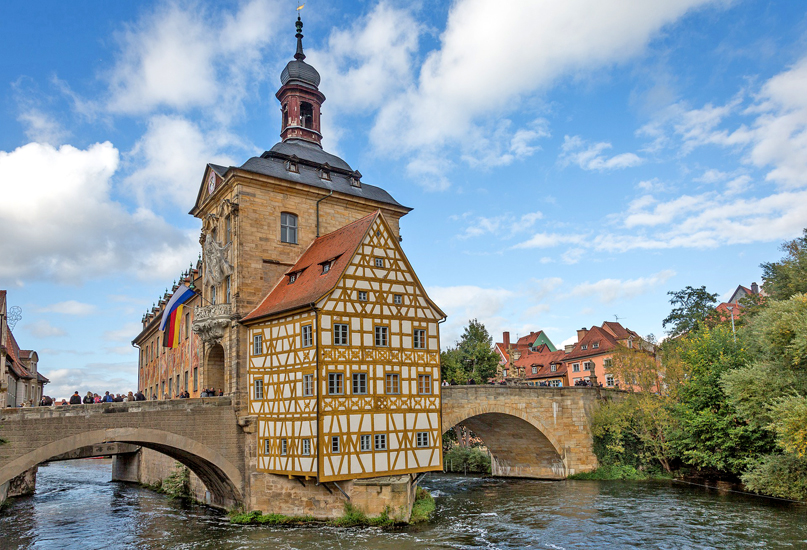Bamberg is a city of district subordination in Upper Franconia, Bavaria, Germany. Located by the Regnitz River.
Arising already in the 7th century, from a fortified fortress on Cathedral Hill, Bamberg at the beginning of the 10th century fell under the rule of the ancient Frankish family of Babenbergs. In 1007, the city became the capital of the episcopal principality and remained it for almost 8 centuries until 1802.
In the first half of the 15th century, during the Hussite wars, Bamberg paid off from plunder. At the same time, there was an uprising against the power of the bishops, but to no avail.
Brewing : Bamberg is widely known for its beer traditions. Part of the beer region of Franconia, the city is located on the border of wine and beer Franconia. Rauchbier is considered a special type of beer in the city – bottom-fermented beer with the taste of malt roasted over a fire. Of the 68 historic breweries, eight survived in 2009. Of these, Schlenkerla, founded in 1405, is world famous. In total, there are 11 breweries in the city.
The city is distinguished by its charming medieval charm, beautiful architecture, interesting monuments and sights in the Gothic and Baroque styles. Bamberg is a city located on seven hills on the banks of the Regnitz River, which has earned the honorable nickname “German Rome”, the historical center of which is included in the UNESCO World Heritage List.
Access : Coordinates: 49.9, 10.9 / You can get to Bamberg from Munich and other major cities in Bavaria and Germany. Distance from the capital of Bavaria – 202 km. Trains and buses run. Travel time – 2.5 – 3 hours. The most economical way to travel is Flixbus buses.
Highlights :
- Cathedral Square, where many of the main attractions of Bamberg are concentrated.Architectural styles and historical periods from Romanesque and early Gothic to Renaissance and Baroque are mixed here.
- One of the most interesting and picturesque places in Bamberg is an artificial island on the Regnitz River with old half-timbered houses, souvenir shops and a beautiful view of the “Venice of Bamberg”
- The main attraction of the island and one of the visiting cards of Bamberg is the Old Town Hall. There is a legend that the local bishop did not permit the construction of this public building on the city land. Two bridges connect the Old Town Hall with the rest of the city – the Lower and the Upper.
- The green market is located in the old Bamberg square and offers fresh fruits and vegetables. Open from Monday to Saturday. The fountain of Neptune is also located on the square.
- Natural History Museum / Historical Museum / Ludwig collection in the Old Town Hall. / Art gallery in the New Residence.
- Parish Church of Our Lady – the only purely Gothic church in Bamberg built in the 14th century / Church of st. Stephen’s is the main Protestant church in the city of the early 19th century.
- The Bishops’ Castle Seehof bei Memmelsdorf is an impressive baroque castle and park complex with a cascading fountain. The most beautiful summer residence of the princes-bishops of the late 17th century.
- Franconian Beer Museum at St. Michael’s Monastery / Historical Museum in the Old Palace on Cathedral Square
- The old town of Bamberg is full of old sights and architectural monuments, narrow winding streets with a romantic medieval atmosphere, cozy taverns and restaurants.
- Cathedral of St. Peter and George is one of the main attractions of Bamberg. It is the legacy of Emperor Henry II. The church was founded at the beginning of the 11th century.
- Monastery of St. Michael is a former monastery of the Order of Benedictine monks, founded by Emperor Henry. The construction with almost a thousand years of history will amaze you with powerful buildings in the neo-Gothic and Baroque style, as well as a beautiful garden.
- the church of St. Jacob. This ancient church, built in the 11th-12th centuries, has retained an exceptionally Romanesque interior despite its baroque facade.
Activities : sightseeing / photo opportunities / walk in town with its old districts / Scenic Driving- Auto Touring / kaffemik – coffee gathering
Go next : Coburg , a city in Upper Franconia. / Erlangen , a city in Franconia, Germany / Nuremberg , Franconia’s largest city / Wurzburg : in Franconia, in northern Bavaria, Germany.

